This is part of a series of reflections on Creative Civic Change, Local Trust’s experimental funding programme that supported 15 communities across England to shape, lead and commission arts and creative interventions, to make positive social change where they lived.
The funding partners, including the National Lottery Community Fund, Esmée Fairbairn, Calouste Gulbenkian Foundation and Local Trust, went on a journey along with communities in Creative Civic Change.
The funders were open to their own learning throughout the programme, and the following is from the final one of the regular sessions we convened, to reflect on what they were noticing and how their own thinking and practice was evolving.
It is important to note that Creative Civic Change is symptomatic of a broader shift that has been happening across the cultural sector over the last five years. A shift towards thinking (if not doing) more about equity and power; about the relationship between cultural ‘providers’ and their communities; and about the role of grassroots or ‘everyday’ creativity.
Whilst Creative Civic Change was distinctive (particularly in how it was funded and led), the programme didn’t invent a way of working that centred community voices; that focused on co-creation; and that was concerned with social outcomes. There is a long and rich history of this work, described and led by individuals such as Francois Matarasso, Chrissie Tiller and Owen Kelly and delivered by programmes like Fun Palaces, 64Million Artists, BAC’s Co Creation Network and ACE’s Creative People and Places.
What did the Creative Civic Change Funders learn?
Funders described many of the same things that projects and communities talked about. They reflected on the importance of:
- Relationships – commenting that Creative Civic Change was not about projects, but people.
- A values-based practice – the usual power relationship was reversed and the project lead considered themselves at the service of the projects, saying ‘I work for them’.
- Honesty and transparency – there was a difficult moment early in the programme when projects were told that they had considerably less budget than they had planned for. The funders were open with communities about this; they said sorry and admitted they got it wrong. Although painful at the time, this helped to build mutual respect and trust across the programme.
- Risk, experimentation and iteration – being open to failure, and having an ‘experimental mindset’, one funder commented that ‘messy is good’.
- Community leadership – how it works, and what it needs.
- Listening – one funder described ‘conversations are the work’, and a number of times during the programme funders heard directly from community members rather than through the filter of the project manager.
- Light touch and flexible frameworks – that enabled the risk and experimentation.
- Timeframes – they considered that three years (as was the original plan) is too short for programmes such as these.
- The value of their partnership – peer learning was important for funders as it was for Creative Civic Change communities; there was safety and support in undertaking such an experiment with colleagues, as you could reflect and learn together.
- The power of creativity for community change – for one funder in particular, the evidence from Creative Civic Change is helping them to understand more about this.

An octopus model that featured in the Whitley Bay Carnival, held by Creative Civic Change collective projects Whitley Bay Carnival, Whitley Bay Big Local and Salto Arts in Whitley Bay.
What were the challenges?
Learning across all the Creative Civic Change funders wasn’t as developed as it could have been, as two of the four organisations changed staff over the four years. One funder, who was more community focused, noted how they had less experience of the creativity aspect of this work. Embedding organisational learning like this is a challenge; staff move on, and priorities shift. It also takes time to translate learning into new policies and practice; funders need to consider a wide range of stakeholders, and organisational change can be slow.
Funders discussed whether the Creative Civic Change approach could be scaled up; would a relational approach be possible in a larger programme? Would funders be comfortable with the level of risk and uncertainty? Did it work partly because its modest scale meant it was ‘under the radar’?
They noted that as well as direct funding to communities to deliver activities, a programme such as this also needs considerable additional resource to provide responsive and flexible support to communities to help them realise their ambitions.
We heard from communities that they valued the fact that funders were learning too, that they were open about sharing this learning, and open to listening to communities. They would though, have valued it even more if funders had travelled to see them; visited their communities and experienced their work in action.
The wider funding landscape
At the time of writing, the cost of living crisis continues to impact communities, and whilst the 2022 Autumn Statement from the Chancellor didn’t include the level of public sector cuts that many feared, there remains significant pressures on local authorities.
Arts Council England announced its portfolio of regularly funded organisations for the period 2023 to 2026, and the Governments’ Levelling Up and Shared Prosperity funding may present opportunities for communities like those in Creative Civic Change areas.
Against this backdrop we held a series of short informal interviews with four funders (two Local Authorities, an arms length body and a Charitable Foundation) who all invest in community–based creativity.
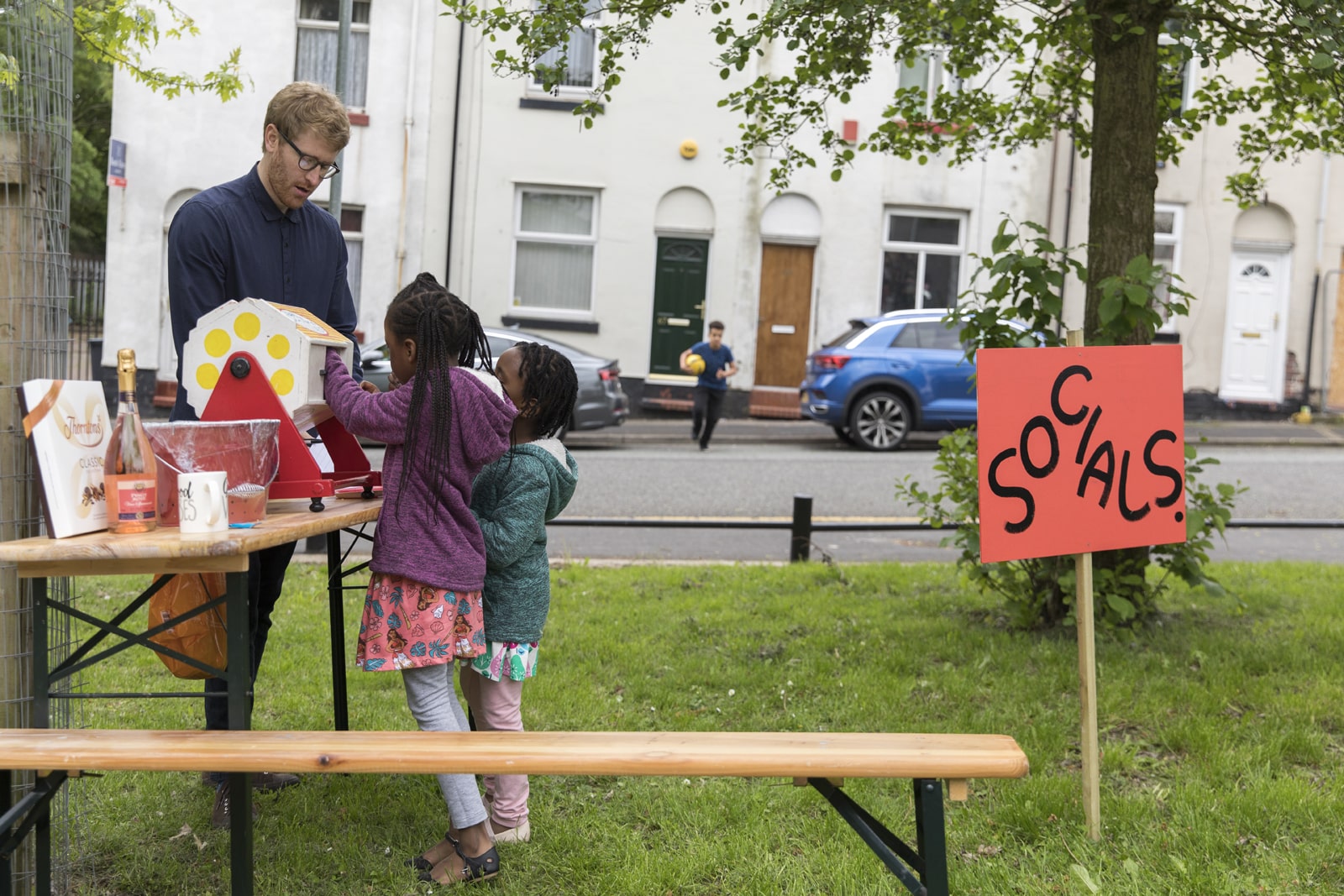
Local residents taking part in a launch event held by Creative Civic Change project, Portland Inn Project.
How is their practice shifting?
Everyone we spoke to agreed that there have been fundamental shifts in funding practice over the last few years. There was a sense that these changes have been driven as much by the grassroots and people in the arts sector, as they have by funders themselves. One interviewee considered that these changes were happening anyway, but how they were accelerated by COVID-19, the Black Lives Matter movement, and the demands of a younger generation.
I think what’s happened in the last couple of years…are that questions around equity and diversity and power and privilege have accelerated in a way that I’ve never seen before.”
Funder
One community funder we weren’t able to speak to at length (because they were in the process of reviewing their entire funding approach) noted that whilst in the past they hadn’t actively funded arts projects, they were now considering the value of creativity and community, as well as thinking about how they could centre anti-racist practice.
Funders we did speak to are asking themselves:
- What is the role of artists in communities?
- Who is leading work like this – artists or communities?
- How do we support communities in this work?
- How do we get money to communities that have been systematically excluded?
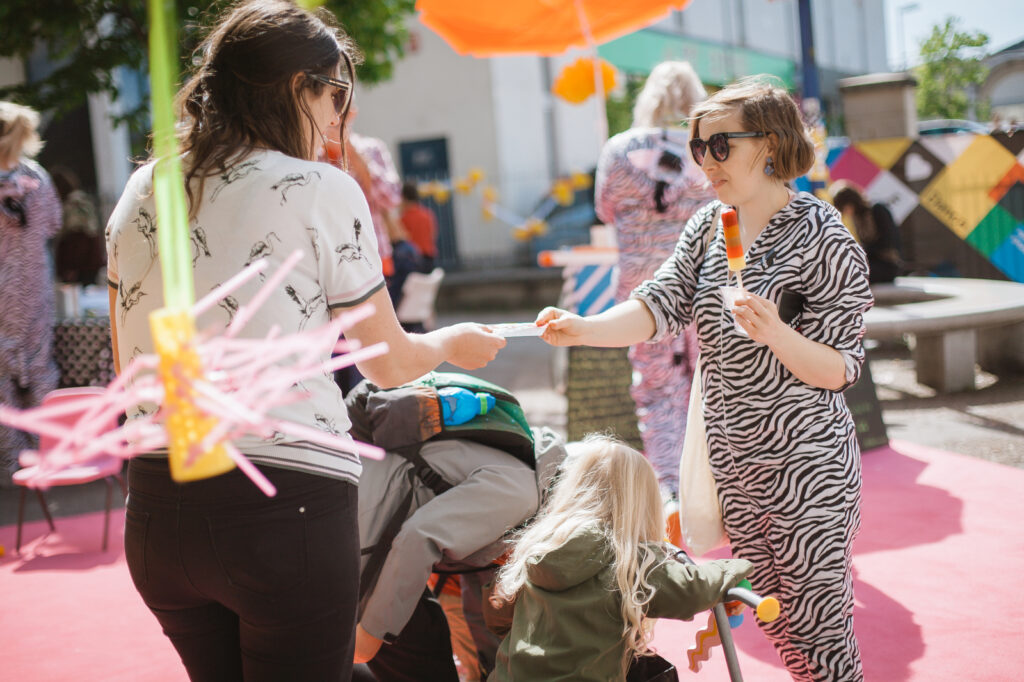
Entertainers interacting with local residents at an event held by Nudge Community Builders, a Creative Civic Change project.
They are operating differently
There is a shift to more long term and core funding, rather than short term projects, and for place based funders a shift away from funding large scale building based organisations and towards smaller scale grassroots creative work.
There is an issue of distribution of money for me. And essentially, what that’s enabled us to do…is that we’ve gradually used that money through Covid and beyond, to completely reshape how we do our enabling work in culture. And it’s absolutely transformed us”
Funder
Funders are working hard to make funding more accessible; developing practices to ensure that funding goes to the people who do the work, not just talk the talk, and there is a willingness to be open about promised activities.
“Actually, organisations are really enjoying that way in which we’ve started funding in very baby steps. Because it gives them the opportunity to really work with people and understand what people want….and it takes the pressure off them because they don’t have to tell us immediately what they’re doing. They’re like, ‘well, we’re going to engage with the people that we want to target first, and then we’re going to tell you what we’re going to do’. And that works really well as a format for us.” (Funder)
There is also a greater focus on outcomes, and resourcing their fundees to think in this way and focus on learning rather than counting.
“We’ve been supporting people with additional resources to establish their evaluation frameworks for quite a long time now. This is because the sector is not very quick to do that work, or hasn’t been very equipped to do that work because they haven’t thought long term and they haven’t thought beyond ‘it’s six workshops, and it’s going to be 20 people in each workshop’. And what we’ve said throughout that piece is that the reason we want that work to be done is not to report back to us, it’s about what are you learning? And how is that changing practice?” (Funder)
There’s also a greater recognition of the role the community sector can play as active partners, and an encouragement of this way of working amongst their fundees.
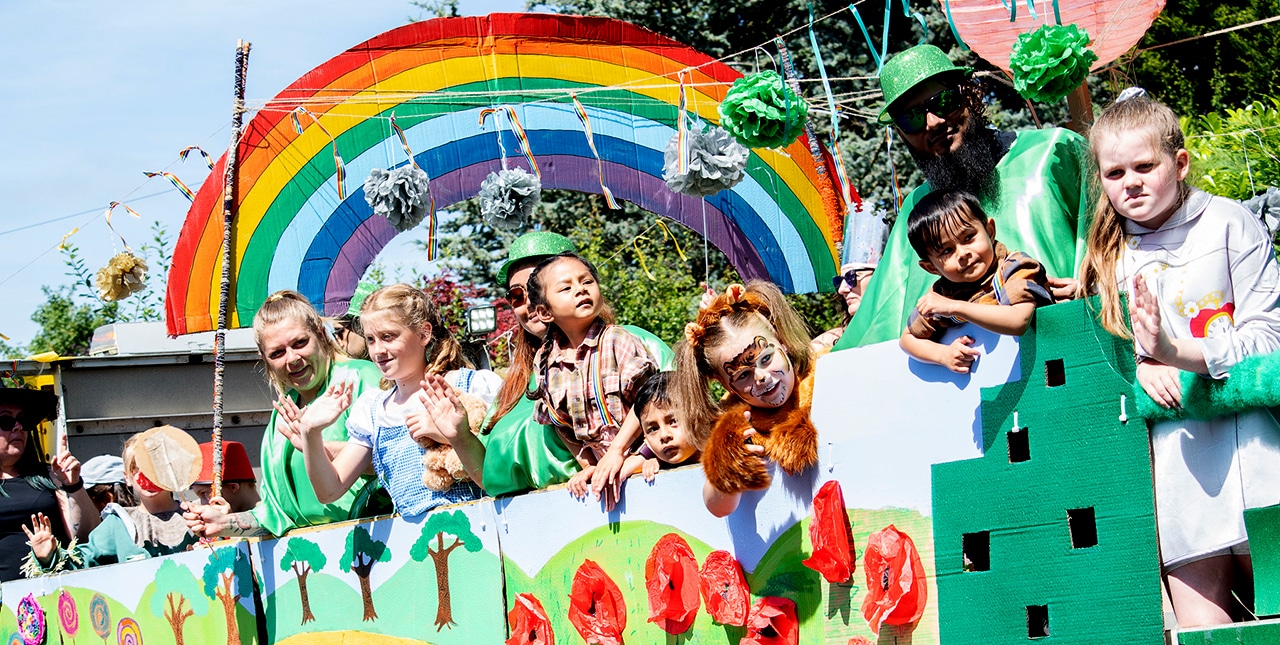
Local children participating in an event held by Greater Creative, a Creative Civic Change project.
What gets in the way?
Everyone we spoke to was committed to this approach, but they conceded there were considerable challenges.
This work is slow, hard and resource hungry; trust takes time to build in communities, and a relational approach needs people.
Parts of the arts sector haven’t caught up – there are still organisations unwilling to give up their power; who are not ready to work alongside their communities.
“I think some of it is attitudinal. And I think we’re still in the territory where lots of people in institutions kind of feel, ‘this is our menu of what we can offer you, what would you like to choose?’ rather than genuinely co creating or having that conversation about how can we bring our resources to what you want to do?” (Funder)
Measuring outcomes for this type of work is hard, and whilst everyone we spoke to can see benefits of a process driven approach, that doesn’t have fixed outcomes at the start; bringing internal stakeholders – whether that is trustees, senior leadership or elected members – with you on this journey can be a struggle.
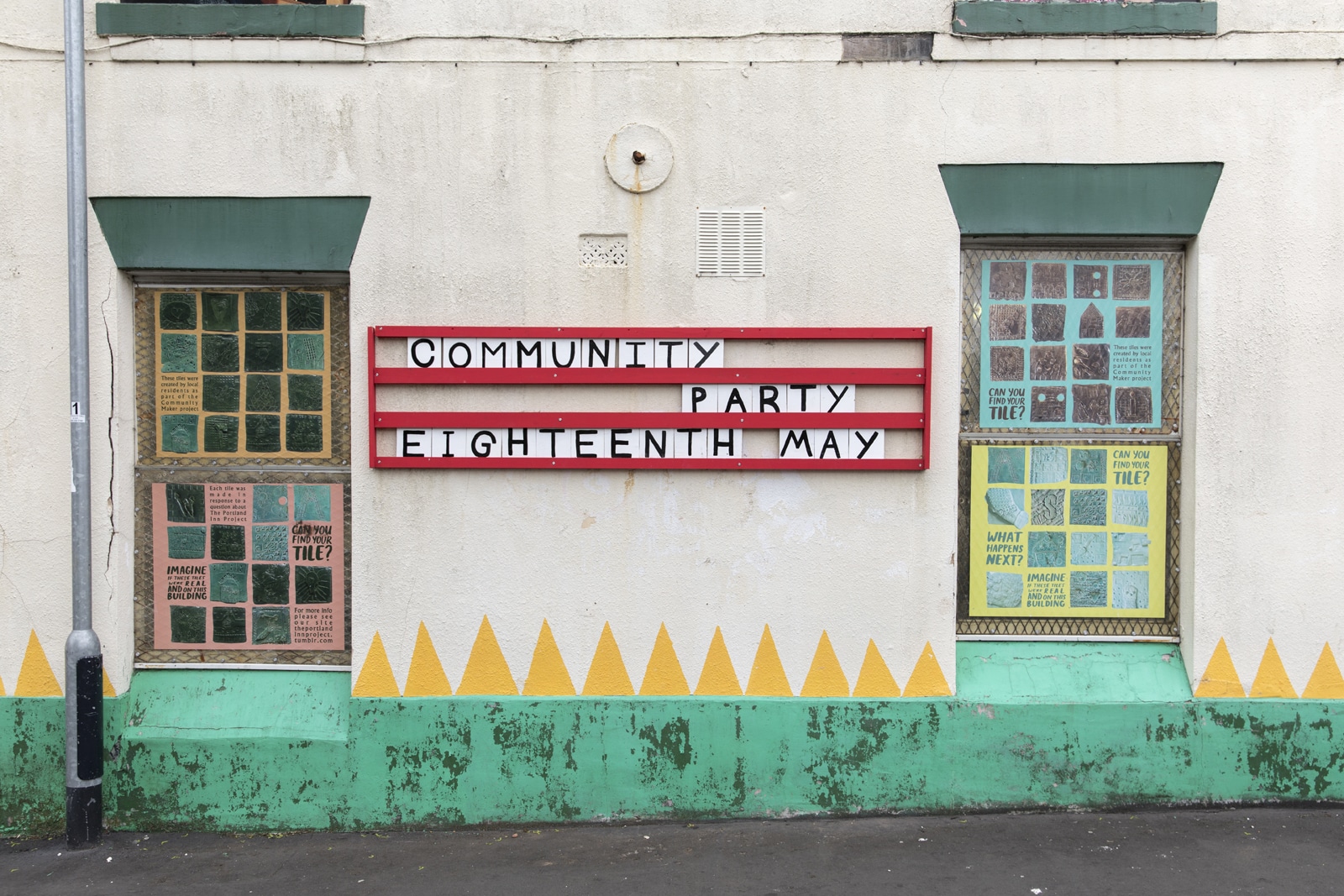
A sign notifying local residents about a launch event held by the Portland Inn Project.
“It’s also a shift for funders, and particularly for trustees of funding bodies, who like a RAG (red, amber, green) system. And they really like to know that something was successful. And you go, ‘well, it’s not as easy as that, because that’s not how we established it in the first place’. So measuring it is hard, it’s slow, it’s long term, it’s deep.” (Funder)
“I have no idea how it’s going to turn out if I’m going to be blunt, because we’ve purposely done it that way, which was interesting to explain to our members. Our portfolio holders can be ‘What do you mean, you don’t know what you’ve commissioned?’ Well, we’ve commissioned the journey really.” (Funder)
Processes and financial accountability, especially for public bodies where there is increased anti-fraud scrutiny since COVID-19, can also get in the way of this flexible, long term, outcomes driven approach. One funder acknowledged that the complexity of their current application processes meant there wasn’t a ‘first point of entry’ for smaller and grassroots groups.
One funder also expressed some anxiety around the ‘quality of art’ question.
“So if you’re an art funder, and you’re used to a kind of model, which is you fund production, or you fund engagement with this artist who’s very well known, and this is what they do, and you’re having to reframe everything around experience, the experience of the participant, rather than the quality of the output. And that shift is really complicated to navigate from a funding point of view.” (Funder)
The combination of skyrocketing energy costs, and rampant inflation, will put even more strain on already stretched budgets. We have already seen how areas like education, learning and participation are the first to be cut when cultural organisations need to make savings, so work like this is particularly vulnerable. Funders we spoke to reflected:
The arts sector is asking, ‘So what’s our core business here…this stuff over here than the messy, hard, long term, complicated stuff, or actually is it about keeping the doors open and putting the stuff on the stage or hanging the stuff in the gallery?’…I can see for many chief execs, they’re exhausted, they’re burnt out, they’re trying to balance impossible budgets at the moment. And something’s going to have to give in all of that.”
Funder
“My nervousness now as a local authority, we are under the cosh again…It’s money that is easy to cut, because it doesn’t directly affect jobs…but of course, it does affect jobs of those we are funding, it affects the wider economy, and it affects communities and confidence and pride and everything that goes with it. So I’m holding the line at the moment, but it’s going be hard.” (Funder)
What are the opportunities?
Despite these concerns, our interviewees considered there were positives going forward.
The possibilities of a place based approach; one that requires different partners across a community to work together to stop duplicating activity, recognise the gaps, and maximise their resources, fits well with this way of working, and could provide real benefits to communities.
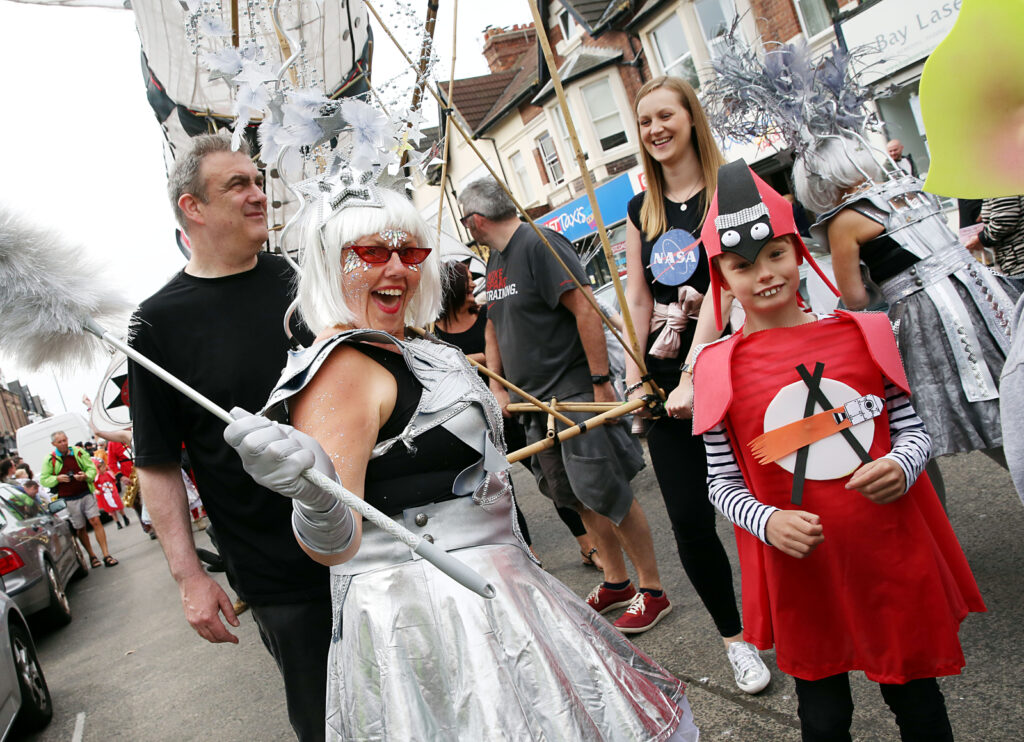
Residents dressed up in costume taking part in the Whitley Bay Carnival, held by Whitley Bay Carnival, Whitley Bay Big Local and Salto Arts in Whitley Bay.
There are an increasing number of supporters and allies who recognise the value of this type of work, and, whilst there is still more to do we are getting better at communicating the benefits.
“We recognise that advocates within the council are really quite important for us, because they’re almost our storytellers internally, as well. So we feed the stories and the data to our supporters, I suppose. And then they do it. And we’re really lucky in that area in that our members are incredibly supportive, and understand the power and impact the culture can have.” (Funder)
There is increasing recognition of the broader social, emotional and wellbeing impacts that creativity can have:
I feel like it might redefine people’s understanding of what creativity and culture actually means, because I think some sometimes we lose the connection between creativity in all parts of our lives, and that it can just be seen as one small thing, which is amazing, of course…but there’s so much more to it. And I think that’s what I hope will come out of how this way of funding is changing that narrative and the position of creativity in people’s lives.”
Funder
Platforming programmes like Creative Civic Change can help to shift attitudes, demonstrating to the wider cultural sector the benefits of this more equitable approach.
“Sharing back and holding a mirror back to the sector, about what it feels like to be a recipient of their largesse or the difference of feeling done with or engaged with rather than done to or patronised…none of this is revelatory…but I think that I think there’s still just a naivety, sometimes in arts organisations actually about how they come over or how they’re perceived.” (Funder)
To find out more about what the 15 Creative Civic Change projects achieved and conclusions made in the evaluation of the programme, visit the website.
